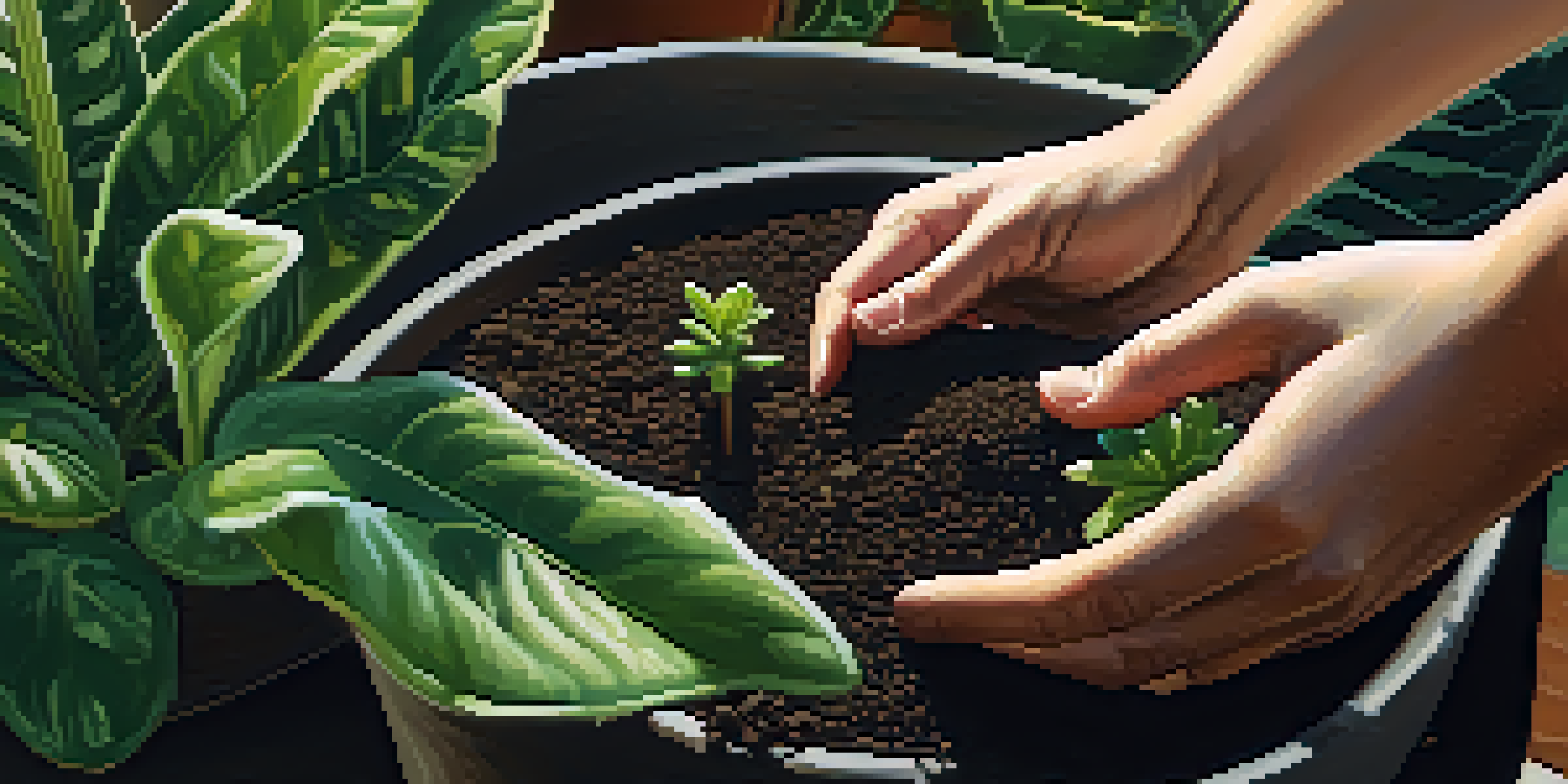How to Create a Watering Schedule for Your Plants

Understanding Your Plant's Water Needs
Every plant has its own unique watering needs, which can depend on species, size, and environment. For instance, succulents require far less moisture compared to ferns, which thrive in more humid conditions. Knowing your plant's specific preferences is the first step in developing a successful watering schedule.
Plants are like people. They thrive on attention and care.
Additionally, factors such as the season and your local climate can influence how much water your plants need. During hot summer months, they may require more frequent watering, while cooler seasons can allow for longer intervals. Keeping an eye on your plant's condition will help you adjust accordingly.
Lastly, consider the size of your pots and the type of soil you're using, as these can affect moisture retention. For example, clay pots tend to dry out faster than plastic ones, meaning you might need to water them more often. Understanding these elements sets the foundation for a tailored watering plan.
Assessing Soil Moisture Levels
Before reaching for the watering can, it's essential to check the moisture level of the soil. You can do this by sticking your finger about an inch into the soil; if it feels dry, it's time to water. This simple test can save you from overwatering, which can lead to root rot.

Another effective method is using a moisture meter, a handy tool that gives you a precise reading. These meters can be especially useful for beginners who may not yet have a 'feel' for their plants' needs. Just remember, different plants prefer different moisture levels, so always refer to their specific requirements.
Know Your Plant's Water Needs
Understanding each plant's specific watering requirements is crucial for developing an effective watering schedule.
Pay attention to changes in the soil's texture over time. Soil should be well-draining, allowing excess moisture to escape while retaining enough for your plants. By regularly checking moisture levels, you can fine-tune your watering schedule for optimal plant health.
Creating a Watering Calendar
Once you understand your plants' needs and how to assess soil moisture, it's time to create a watering calendar. Start by noting the types of plants you have and their specific watering schedules. For example, cacti might only need water every two weeks, while leafy greens may require it every few days.
The best time to water your plants is when you see them drooping.
A simple way to organize this is by using a digital calendar or a physical planner, marking down when each plant needs watering. This visual aid can help ensure you don’t forget a plant, especially if you have a diverse garden. It also allows you to adjust based on seasonal changes easily.
As you follow your calendar, take notes on how your plants respond. If you notice a plant thriving with less water or wilting despite regular watering, adjust your schedule accordingly. This will allow your watering calendar to evolve alongside your plants' needs.
Timing Your Watering Sessions
The timing of your watering sessions can significantly impact your plants' health. Ideally, watering early in the morning or late in the afternoon is best, as it allows the moisture to soak in before the sun evaporates it. This practice ensures your plants receive the hydration they need without wasting water.
Avoid watering in the heat of the day, as the sun can scorch the leaves and lead to rapid evaporation. If you must water during the afternoon, aim to do so at a time when the sun's intensity is lower. This small adjustment can make a noticeable difference in how well your plants absorb water.
Create a Watering Calendar
Organizing a watering calendar helps ensure you meet the hydration needs of various plants consistently.
Additionally, consider the routine of your watering schedule. Consistency is key, so try to water at the same time each day or week. This way, your plants will come to expect their hydration, promoting better overall growth.
Adjusting for Seasonal Changes
As the seasons change, so do your plants' watering needs. In spring and summer, many plants enter a growth phase and may require more frequent watering. Conversely, during fall and winter, many plants go dormant and need less water, so it’s essential to adjust your schedule accordingly.
Watch for signs of seasonal changes in your plants, such as leaf drop or slowed growth. These may indicate that it's time to reduce watering. Similarly, if your plants are growing vigorously, you might need to increase their hydration to support that growth.
Keeping a seasonal log can help you track these adjustments year by year. This way, you’ll build a better understanding of how your plants react to seasonal shifts, allowing you to create a more effective watering schedule.
Using the Right Watering Techniques
How you water your plants can be just as important as how often you do it. Deep watering is typically more beneficial than shallow watering, as it encourages roots to grow deeper into the soil. Aim to thoroughly soak the soil until water drains from the bottom of the pot.
Avoid using overhead watering methods for indoor plants, as this can lead to water pooling on the leaves and increase the risk of fungal diseases. Instead, consider using a watering can with a narrow spout or a drip irrigation system for more controlled watering.
Monitor and Adapt Your Schedule
Regularly observing your plants allows you to adjust your watering practices based on their responses and seasonal changes.
Lastly, remember that different plants may benefit from different techniques. For example, some plants prefer bottom watering, where you place them in a tray of water for a while. Experimenting with various methods can help you discover what works best for each of your plants.
Monitoring and Adapting Your Schedule
Creating a watering schedule is just the beginning; monitoring and adapting it is essential for plant health. Regularly check on your plants and observe how they respond to your watering regime. If you notice signs of overwatering, such as yellowing leaves, or underwatering, like wilting, it's time to make adjustments.
Consider keeping a journal to track your observations, noting any changes in plant behavior or environmental factors that might affect watering. This record will help you identify patterns and refine your schedule over time, ensuring your plants remain healthy and vibrant.

Lastly, remember that each plant may require individual attention. While a general schedule is helpful, being adaptable is key. By listening to your plants and responding to their needs, you can cultivate a thriving garden that brings you joy.